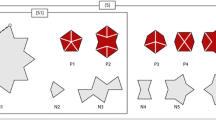Abstract
Looking at the heritage of traditional Persian pentagonal patterns (patterns made from tiles derived from the pentagon), one can suppose that the artists, very early on, have set targets for their creation. One is the search for self-similarity; another is the search for methods of connection between the two main families of patterns. It is strange and intriguing that the historic artists did not fully achieve these targets.
This paper, following a previous publication (Castera, Nexus Netw J 18:223, 2016), proposes solutions and new developments.
There are no Penrose patterns in that story; only binary tiling and the X-Tiles.
Access this chapter
Tax calculation will be finalised at checkout
Purchases are for personal use only
Similar content being viewed by others
References
Binary tilling: http://www.quadibloc.com/math/pen02.htm
Bonner J (2017) Islamic geometric patterns. Their historical development and traditional methods of construction. Springer, New York
Castera JM (1996) Arabesques: Art Décoratif au Maroc, ACR Edition, Paris (English edition in 1999)
Castera JM (2011) Flying patterns. In: Proceedings of the ISAMA/Bridges, Coimbra. Can be downloaded from Bridge’s web site, or from http://castera.net/entrelacs/public/articles/Flying_Patterns.pdf
Castera JM (2016) Persian variations. Nexus Netw J 18:223. https://doi.org/10.1007/s00004-015-0281-5
Castera JM, Jolis H (1991) Géométrie douce. Atelier 6½, Paris
Cromwell PR (2009) The search for quasi-periodicity in Islamic 5-fold ornament. Math Intell 31(1):36–56
Kond to Kond: http://www.quadibloc.com/math/pen05.htm
Lee AJ (1987) Islamic star patterns. In: Grabar O (ed) Muqarnas IV: an annual on Islamic art and architecture. E.J. Brill, Leiden, pp 182–197
Makovicky E (1992) 800-year old pentagonal tiling from Maragha, Iran, and the new varieties of aperiodic tiling it inspired. In: Hargittai I (ed) Fivefold symmetry. World Scientific, Singapore, pp 67–86
Mofid H, Raieszadeh M (1995) Revival of the forgotten arts: principles of the traditional architecture in Iran according to Hossein Lorzadeh. Mola Publications, Tehran. (In Persian)
Necipogglu G (1995) The Topkapi scroll: geometry and ornament in Islamic architecture. Getty Center Publication, Santa Monica
Pelletier M (2013) Zellij Qusicrystals – A Gallery, Les tracés de l’Arabesque géométrique. Académie des Arts Traditionnels, Casablanca
Shaarbaf A (1982) Ghirih and karbandi, vol 1. The National Organization for Protection of Iran’s Antiquities, Tehran
I strongly recommend also the reading of every publication from Antony Lee, Peter Cromwell (available on https://girih.wordpress.com/), Emil Makovicky and Craig Kaplan
With a special mention to the recent brilliant work of the French mathematician Armand Jaspar, available on line: http://patterns-islamiques.fr/
Author information
Authors and Affiliations
Corresponding author
Editor information
Editors and Affiliations
Section Editor information
Rights and permissions
Copyright information
© 2021 Springer Nature Switzerland AG
About this entry
Cite this entry
Castera, JM. (2021). TOND to TOND: Self-Similarity of Persian TOND Patterns, Through the Logic of the X-Tiles. In: Sriraman, B. (eds) Handbook of the Mathematics of the Arts and Sciences. Springer, Cham. https://doi.org/10.1007/978-3-319-57072-3_58
Download citation
DOI: https://doi.org/10.1007/978-3-319-57072-3_58
Published:
Publisher Name: Springer, Cham
Print ISBN: 978-3-319-57071-6
Online ISBN: 978-3-319-57072-3
eBook Packages: Mathematics and StatisticsReference Module Computer Science and Engineering



